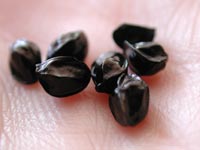Hybridizing Daylilies
Sooner or later, most daylily gardeners become intrigued with the notion of creating new hybrids. Daylilies are relatively easy to cross pollinate and creating your own hybrids can be an exciting prospect.
The concept & practice of creating daylily hybrids is quite simple. In very basic terms, you manually pollinate a flower with the pollen of another flower to create a new plant that will be a cross between the parent plants. Determining and defining your objectives and selecting the appropriate parent plants with the traits that you hope to achieve and then perfecting those traits through multiple generations is a more complex procedure.
How to Pollinate a Daylily
In the center of a daylily flower, there are typically six stamens and one pistil. The stamens have pollen (a powdery substance) on their ends. To cross pollinate two daylilies, you need to take the pollen from one flower (referred to as the pollen parent plant) and apply it to the tip of the pistil on another flower (referred to as the pod parent plant).

Daylily Seeds
Once you've pollinated a flower, you will want to tag it and keep an eye on it. If the cross pollination was successful, a small green seed pod will start to appear where the flower once was on the pod parent daylily. Once the seed pods form completely, turn brown, and start to split open, you can collect the seeds for germination and begin the process of planting. It's really that simple.
After you've experimented with some daylily hybridizing and have experienced results, you'll probably start to get a bit more serious about it. Keeping detailed records is imperative for the serious hybridizer. You'll also start to get more familiar with the different traits of daylilies and begin to better plan for obtaining your objectives.

